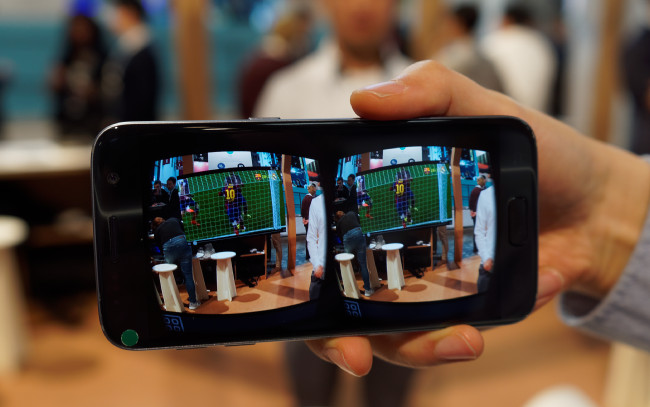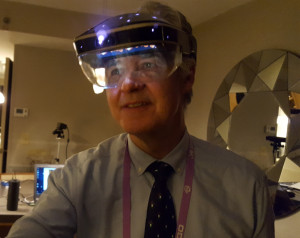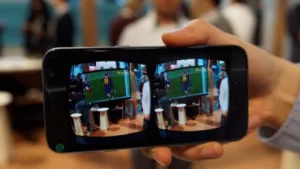My name’s Bob and I’m a pixelaholic. Although I try to make do with fewer pixels, the truth is that as time goes on I just need more and more to feed my habit.

I’m on a business trip at the moment (Passenger Terminal Expo and the Electronic Display Conference/Embedded World) and I’m trying to catch up with some work. Unfortunately, I designed my spreadsheets on, and am used to using, a 31.5″ UltraHD monitor. That’s eight megapixels – by some way the most I’ve ever regularly consumed, and usually alongside my notebook ‘chaser’ screen that gives me another four.That makes me a heavy pixel user with a regular diet of 12 megapixels in total. However, on the road, I only have the small screen, still 4 megapixels, but with text that’s small for my aging eyes.
 Samsung’s Monitorless Project puts a PC screen on a smartphone-based headset. Image:Meko
Samsung’s Monitorless Project puts a PC screen on a smartphone-based headset. Image:Meko
 The author being underwhelmed by Meta at AWEAt the recent MWC event, I looked at some technology from Samsung’s R&D group under the MonitorLess project name, that sends a PC desktop to a mobile phone that shows the display as a virtual screen on the phone display when it is used in a VR mode. (MWC 4YFN Show Buzzes – subscription required)
The author being underwhelmed by Meta at AWEAt the recent MWC event, I looked at some technology from Samsung’s R&D group under the MonitorLess project name, that sends a PC desktop to a mobile phone that shows the display as a virtual screen on the phone display when it is used in a VR mode. (MWC 4YFN Show Buzzes – subscription required)
That’s what I could do with now, a connection to my home PC (well, of course, it’s with me, actually). It would be nice to connect to a big virtual screen in a headset, I thought. Similar technology has been shown by a number of companies including Meta that we saw (and were underwhelmed by) at the Augmented World Expo last year in San Jose. (Meta Misjudges the AWE Tone – subscription required).
We have also reported on an impressive looking app called Bigscreen that’s available on Steam (although we haven’t had a chance to play with it, yet (‘Bigscreen’ Looking to Virtual Working – subscription required)
There was also a collaboration app from a company called Telesoftas that we reported on from the Showstoppers event at Mobile World that allowed virtual screens in 3D VR applications. (Showstoppers is Busy – Blame the Beer! – subscription required)
It’s clearly one of the apps that Microsoft is looking towards with its Hololens project, although an interesting article at Thurrott.com https://www.thurrott.com/hardware/90780/microsoft-accelerates-hololens-v3-development-sidesteps-v2 suggests that Microsoft has decided to skip a stage in Hololens development and wait until 2019 for a refresh, on the grounds that there is not a lot of competition around at the moment. I’m off to France next week to Laval Virtual – a fun VR event – and no doubt there will be other companies there with this kind of technology.
Now, as a confirmed pixelaholic, I’m not really bothered whether the pixels are virtual or real, so the idea of these headsets is good. But there are some issues. First, as I’m sitting on the train at the moment and have several hours work ahead, I don’t think I’d be comfortable wearing ‘goggles’ for that period of time. I might be happy to wear some kind of mixed reality glasses or device, but the reality is that the limited resolution and field of view of current augmented reality devices would mean that I wouldn’t be able to see the full screen – in fact, I wouldn’t be able to see as much as I do on my notebook without moving my point of view or the virtual display.
Then there’s the question of interaction. At the moment, there is nothing that beats a hardware keyboard. So, for now, I’m not convinced that other than applications where an external display is not possible, general productivity use is not going to be widespread. It’s a great idea, but unless you can extend the number of pixels I can see at the same time, I don’t see the big benefit.
On the other hand, for entertainment….
On the other hand, at Mobile World, on the SK Telecom ‘future technologies’ booth, I did see a nice virtual screen app. This, though, was for watching sport – baseball in the example shown. The system used a 360º video of a baseball match. Views from multiple locations were available. The 360º video gave the impression of sitting in a seat in the stadium. So far, so conventional. However, there were two other virtual displays in the image. One was delivered as a window on the 360º video and was designed to look like a very large LED display on the far side of the stadium that was showing close ups of the action. The second was like a small scoreboard at the bottom of the display when the viewer looked forward.
The app used gaze recognition to detect when the user was focusing on the close up screen or the scoreboard. If the gaze stayed on that for a longer time, the system assumed you wanted more and switched to a much bigger close up view or to a bigger scoreboard with more information. That was very nice indeed and I could imagine enjoying the coverage of sports significantly more with this kind of seamless integration between the apparently real and the virtual. Unfortunately, as the app was only shown on VR glasses, I couldn’t get a good image, but I was impressed with the technology. Staff told us that the combination of the three different displays (360/close-up/information) was being performed in the VR client device, but in the longer term, the idea is to do this in the cloud and just stream the finished video to the user.
Bob

